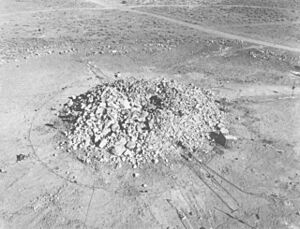Operation Whetstone facts for kids
Quick facts for kids Operation Whetstone |
|
|---|---|
| Information | |
| Country | United States |
| Period | 1964–1965 |
| Number of tests | 46 |
| Test type | cratering, underground shaft, tunnel |
| Max. yield | 51 kilotonnes of TNT (210 TJ) |
Operation Whetstone was a series of nuclear tests carried out by the United States. These tests happened between 1964 and 1965. A nuclear test is when a country explodes a nuclear device to see how it works or what effects it has.
This series included 46 different tests. It took place after a series called Operation Niblick and before Operation Flintlock. The United Kingdom also conducted two tests during this time, named Cormorant and Courser.
Contents
Operation Whetstone: Nuclear Tests in the 1960s
Operation Whetstone was an important part of the United States' efforts to develop and understand nuclear technology during the Cold War. These tests were done underground to follow international agreements. The goal was to learn more about how nuclear devices worked and how they could be used safely.
What Was Operation Whetstone?
Operation Whetstone was a collection of 46 nuclear tests. Most of these tests were done deep underground in shafts or tunnels. One test, called Sulky, was a "cratering" test. This means it was designed to create a crater on the surface.
The most powerful explosion in this series was Wagtail, which had a yield of 51 kilotons. To give you an idea, a kiloton is equal to 1,000 tons of TNT. So, 51 kilotons is like 51,000 tons of TNT exploding!
Where Did These Tests Happen?
Most of the tests in Operation Whetstone took place at the Nevada Test Site (NTS). This is a large area in Nevada, USA, where the United States conducted many nuclear tests. One special test, named Salmon, was done in Mississippi. This test was part of a project to learn how to detect underground nuclear explosions from far away.
Why Were These Tests Done?
The tests in Operation Whetstone had several purposes:
- Weapons Development: Many tests helped scientists improve nuclear weapons. They wanted to make them more reliable or smaller.
- Safety Experiments: Some tests were designed to make sure nuclear weapons were safe. They checked what would happen if a weapon was accidentally dropped or caught fire.
- Peaceful Research (Project Plowshare): A few tests were part of a program called Operation Plowshare. This project explored using nuclear explosions for non-military purposes. For example, they looked into using them for digging canals or mining. The Sulky test was one of these Plowshare experiments, studying how to dig hard, dry ground. Another Plowshare test, Handcar, studied how explosions affected carbonate rock.
What About Other Countries?
During Operation Whetstone, the United Kingdom also carried out two of its own nuclear tests. These tests, Cormorant and Courser, were conducted at the Nevada Test Site. This shows how countries sometimes worked together or shared testing sites during this period.
Understanding the Effects
When these underground tests happened, sometimes a small amount of gas or particles would escape to the surface. This is called "venting." Scientists would detect this venting to study the effects of the explosions. For example, the Alva test caused venting that was detected far from the test site. The Sulky test also vented, and scientists studied how radioactive materials spread from it.


